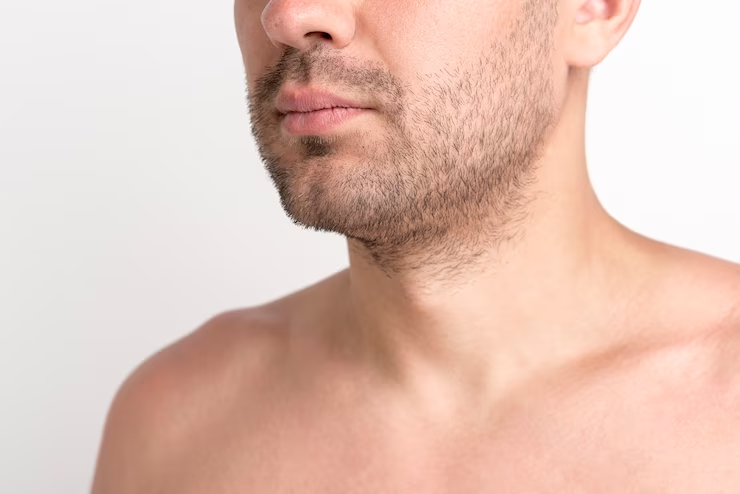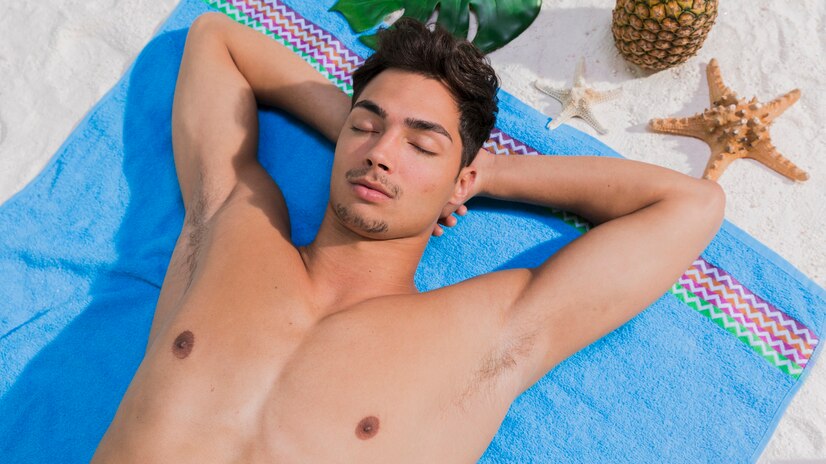
Acne can appear anywhere you have oil glands in your skin, so it can occur on your back, face, stomach or chest. Chest acne is a type of folliculitis (inflammation of the hair follicles). It is caused by clogged pores from sebum (oil), dead skin cells and other debris. A specific type of bacteria called propionibacterium acne can multiply in clogged pores. As a result the skin becomes inflamed causing white heads, black heads and pimples.
Chest pimples can have a significant impact on a person's self-esteem. They may make you feel self-conscious, especially in the locker room or gym with other people. For some, chest pimples are a minor inconvenience that can be easily treated with over-the-counter products. However, other people experience more severe symptoms that require medical treatment.
Whatever the cause, chest pimples aren't anything to worry about! In this blog post, we will talk about how chest pimples can be a symptom of something more serious and how addressing the issue now can help you avoid future problems.
Causes of Chest Pimples
Chest acne can be caused by genetics, hormones, lifestyle habits, diet and stress. Chest acne develops the same way as acne on any other part of your body. But following factors are identified as quite specific for developing chest acne.
Friction from clothing
Excessive sweating
Using skin care products that prevent water loss
The factors below can cause or worsen acne anywhere in the body including the chest.
Hormonal fluctuations
Hormonal fluctuations commonly cause chest pimples, especially in teens and young adults. As you go through puberty, your body produces more hormones, which can cause acne on parts of your body. This is because the hormones (especially testosterone) stimulate oil production in your skin, causing the skin to become more oily and clog pores.
Consuming sugary foods, skim milk and refined carbs
Sugary foods are notorious for causing acne. The quick spikes in blood sugar from eating too much sugar can cause a sudden increase in hormones, leading to acne breakouts.
Using certain medications - like corticosteroids, testosterone or lithium
Stress - when your body is under stress, the androgen production increases leading to acne.
Not drinking enough water
Dehydration is a big factor in chest pimples, making your skin dry and flaky. As your skin dehydrates, it becomes more likely to develop acne because of the buildup of dead skin cells. This can also make your pores clog up and become inflamed.
Too much friction
Working out can cause friction between your skin and clothes, leading to chest acne. The friction causes little tears in your skin that become infected with bacteria, which can lead to pimples. This is especially likely to happen if you're working out in tight-fitting clothing.
Sun exposure
When you're outside, your body loses water through sweat. This can lead to dryness, which causes your skin to become chapped or cracked. The resulting inflamed area is more susceptible to breakouts. You can help prevent this by using moisturizer twice a day and always wearing sunscreen outside.
It is important to note that chest acne is not the result of poor hygiene. It is not caused by dirty skin. The truth is acne can worsen with too much washing with harsh soaps and chemicals and rough scrubbing.
Symptoms of Chest Pimples
Whiteheads (closed comedones)
Whiteheads are small, hard bumps on the chest, back, and shoulders. The buildup of sebum and dead skin cells underneath the skin usually causes them when whiteheads occur in areas with large amounts of hair, such as the chest area.
The best way to prevent whiteheads is by keeping your skin clean: wash your chest at least twice a day with a gentle soap or an acne-fighting cleanser (that doesn't contain harsh chemicals or alcohol). You should also exfoliate once or twice per week to remove dead skin cells from the surface of your skin and keep pores clear from debris buildup. However, avoid rough scrubbing.
Blackheads (open comedones)
Blackheads
Pustules
Pustules
Papules
Papules
Nodules
Nodules
Cyst
Cysts are painful pus filled lumps under the skin.
Lifestyle Adjustments to Reduce Chest Pimples
If you're looking for ways to reduce the appearance of your chest pimples, you can make some simple lifestyle adjustments.
Keep the chest area clean
You don't have to wash it every time you take a shower—make sure that when you do, you use mild soap without harsh ingredients like fragrance or alcohol. This will help prevent clogged pores from becoming infected and causing more pimples. Wash if you sweat excessively especially after a workout.
Avoid fitted clothes
Avoid wearing tight clothing that rubs against your chest, and traps heat against your body. This will only exacerbate any existing inflammation or irritation in the area.
Skip sugary foods
You should also avoid junk food and other processed food that contains refined sugar, corn syrup, and other refined carbohydrates. These foods are linked with an increased risk of developing acne and pimples.
Avoid wearing perfume & lotion
Avoid applying perfume or lotions to your chest area as they have strong fragrances and can cause irritation in your skin. Alternatively, try using unscented lotion on your chest area after you shower or bathe.
If you have recently switched from one brand to another, trying a different product on your chest might be worth seeing if it helps clear up any existing breakouts.
Opt for hypoallergenic detergent
Dyes and scents are commonly found in laundry detergents, so choosing a brand that only uses color-safe, scent-free ingredients is important. This will help you avoid any potential skin reactions to the chemicals in your laundry detergent.
Effective Ways to Treat Chest Pimples At-Home

There are quite a few treatments available for chest acne which help you to avoid skin scars, make your chest pimples less noticeable and reduce the emotional stress caused by the chest acne. Use gentle scrubs and non comedogenic creams so that your skin pores don’t get clogged. Over-the-counter body washes that include salicylic acid and benzoyl peroxide can provide some relief to mild inflammatory chest acne. Also, avoid coarse or rough body scrubs, as they are traumatic to the skin and worsen your chest pimples.
Alpha-hydroxy acids (AHAs) and beta-hydroxy acids (BHAs)
Alpha-hydroxy acids (AHAs) and beta-hydroxy acids (BHAs) are two types of topical acne treatments that can help treat chest pimples. They reduce the skin's oil production, helping to reduce or prevent the formation of new pimples.
Skin care products with AHAs or BHAs include lactic acid, glycolic acid, and salicylic acid. These ingredients are found in moisturizers, toners, cleansers, and masks. They're also available in spot treatments for acne breakouts.
Retinol
Retinol can help clear up your skin, reduce inflammation, and prevent new chest acne from forming. It comes in many forms, including creams and gels. When using a retinol product, avoid getting it near your eyes or mouth. You should also avoid using it on broken or irritated skin, which may cause irritation or other side effects.
Benzoyl peroxide
Benzoyl peroxide is a medication that works by killing the bacteria that cause acne, and it also helps to dry out excess oil. You can use benzoyl peroxide in many forms: as a wash, a lotion, and even a gel. Following the directions carefully when using this treatment is important, as it can cause redness and irritation if overused.
Disclaimer
It is important to note that the following adverse effects are possible with any acne products and should be taken into consideration before using them.Skin irritation
– While most people find their skin to be more sensitive after using acne products, in some cases, this sensitivity can become too uncomfortable for continued use. In extreme cases, acne products can cause skin inflammation, leading to redness and pain for users.Sensitivity to the sun or UV light
– While the damage caused by UV light is usually temporary and reversible (for example, if you use sunscreen), it can still be dangerous. If you notice your skin becoming more sensitive after using acne products, discontinue use immediately and consult your dermatologist.As with any acne product, there are some things you should know before using it. Acids and retinoids can cause irritation and dryness, so practicing sun safety is important when using them.
Use a sunscreen
that has SPF 30 or higher. Wear it every day, even when you're not in the sun.Wear a hat
with a brim and long sleeves if you are outdoors for a long time.If you can't avoid being in the sun for an extended period (more than 30 minutes),
seek shade or stay out of direct sunlight
by wearing opaque clothing.Reapply sunscreen every 2 hours
throughout the day for maximum protection.
Clinical Treatment Options For Chest Pimples
Prescription medication
Topical or oral antibiotics
are the most common treatment for chest acne, and dermatologists often prescribe them.These medications can be taken orally or applied directly to the affected area, and they are effective at treating chest acne because they kill P. acnes bacteria. However, oral antibiotics aren't recommended for long-term use because they can cause serious side effects like stomach upset or diarrhea.
Topical retinoids
are used to treat mild to moderate acne on the face and body, including chest acne. They come in different forms (creams, gels, lotions). You'll need to apply these products every day for 4-8 weeks before seeing results because it can take time for your skin to adjust to the medication.Laser Therapy
Laser therapy is a treatment for chest acne that uses laser beams to destroy the oil-producing glands in your skin. It is less suitable for cystic or severe cases of acne, but it can be used in milder cases.
Corticosteroids
Corticosteroids are powerful anti-inflammatory drugs that help reduce the pain from acne and inflammation. These injections are given into the skin or muscle, and they work by reducing swelling and redness. They're often used for short periods, but frequent use can cause side effects.
Conclusion
Chest pimples are a common skin condition that can be caused by anything from an allergic reaction to the sun to a reaction to medication. While they may be unsightly and uncomfortable, they are rarely anything to worry about.
The best treatment for chest pimples is prevention. If you've had a reaction, talk to your doctor before taking any medications. They'll help you figure out what caused it so that you can avoid it in the future.
If you're sure that your chest pimples are just a result of an allergic reaction, try using over-the-counter products to help reduce redness and itching. See your doctor for further evaluation if your symptoms persist after two weeks.









